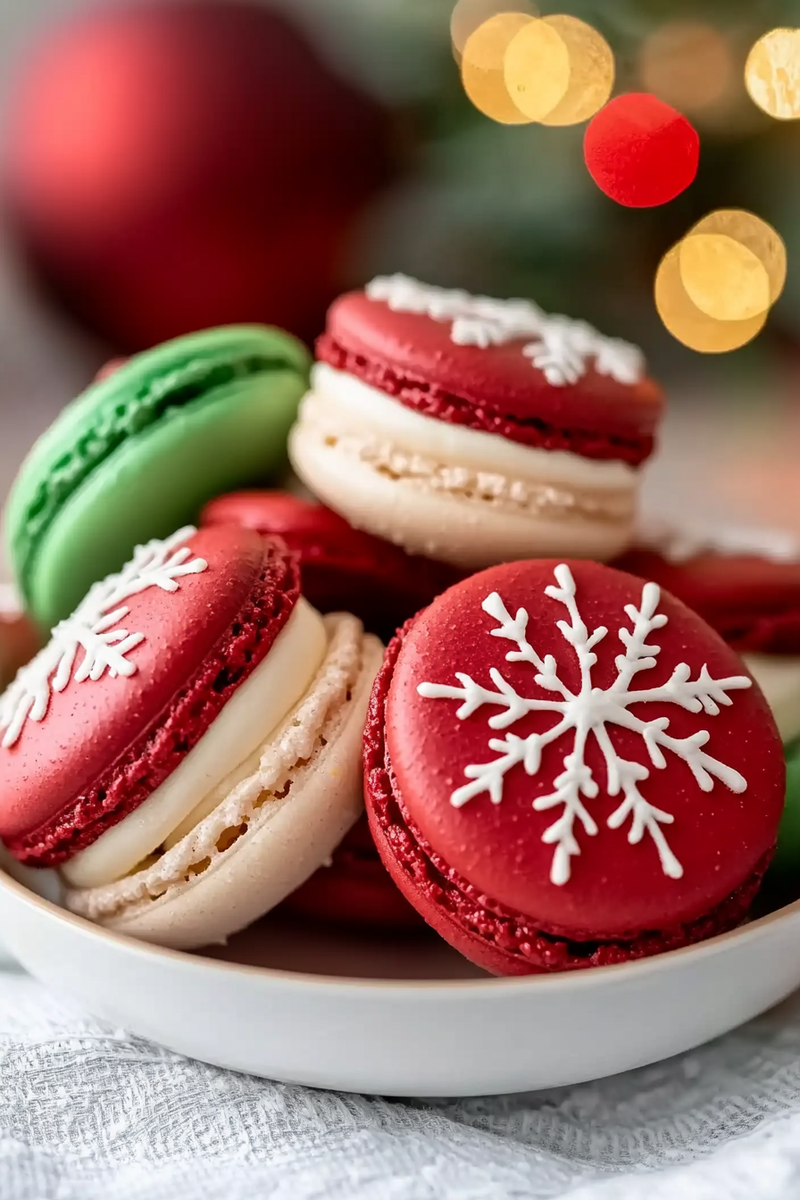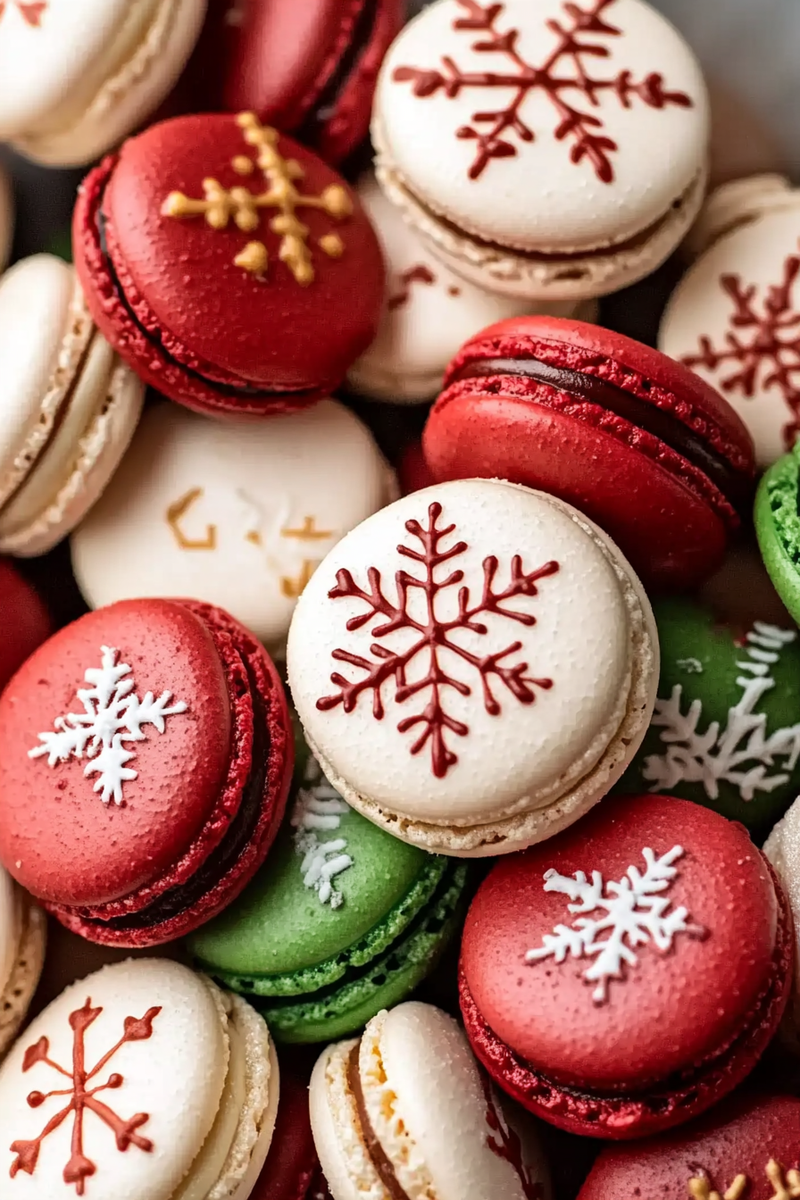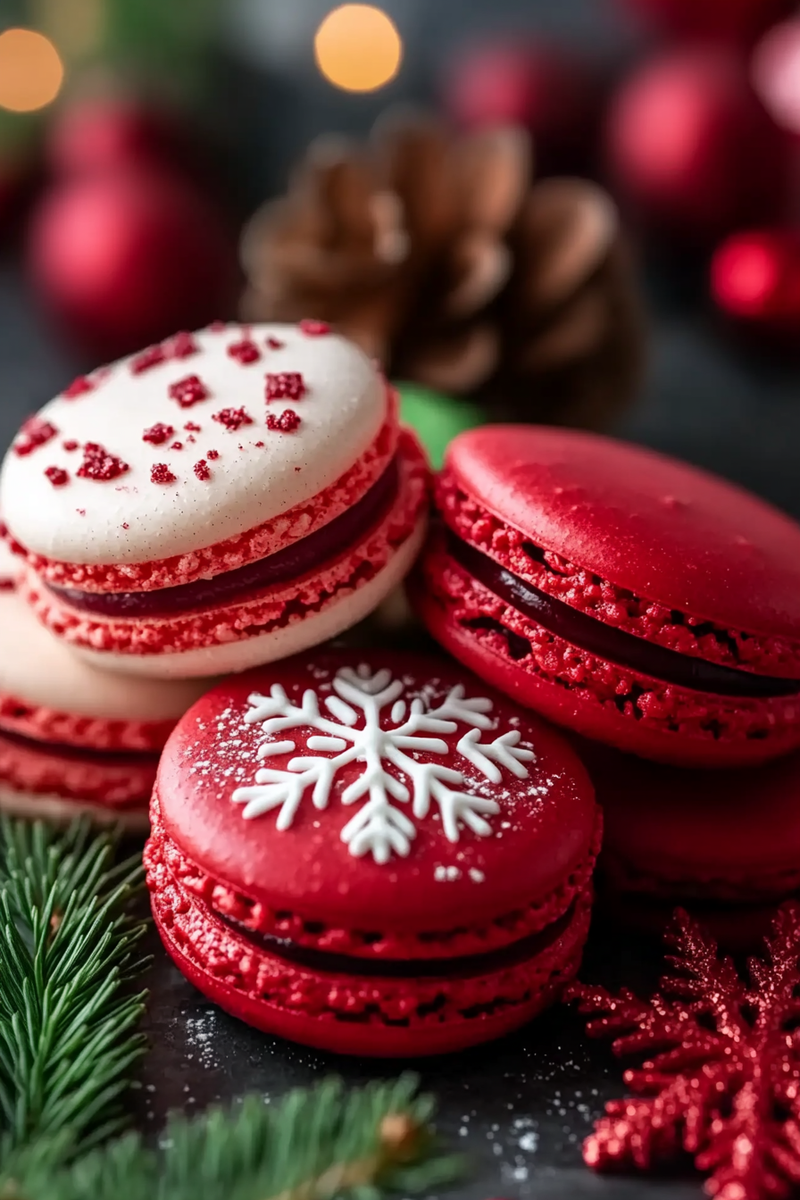Introduction and Quick Summary
Christmas is a time of joy, celebration, and of course, delicious treats! One delightful addition to your holiday table can be none other than the festive Christmas macarons. These delicate French cookies not only look stunning but also offer a variety of flavors that can brighten any gathering. Their vibrant colors and unique fillings make them perfect for gift-giving or as a sweet treat to serve at parties. In this article, we will guide you through the entire process of making these charming confections from scratch. You’ll learn about the essential ingredients needed and follow our detailed step-by-step instructions to ensure perfect results every time. The best part? You can customize these festive Christmas macarons to match your holiday theme! Whether you want classic peppermint or rich chocolate ganache filling, we’ve got you covered. So gather your ingredients and get ready to impress your family and friends with these delightful little gems that taste as good as they look.
Main Ingredients
Almond Flour
Almond flour is a key ingredient in making macarons. It provides the necessary texture and flavor for these delightful cookies. For this recipe, you’ll need 120 grams of finely ground almond flour. Make sure to sift it before mixing to remove any larger pieces that could affect the smoothness of your macaron shells. Almond flour not only adds a nutty taste but also contributes to the overall lightness of the cookies.
Powdered Sugar
Powdered sugar is essential for achieving the right sweetness in your macarons. You will need 210 grams for this recipe. The fine texture dissolves easily when mixed with the almond flour, ensuring a smooth batter. Sifting the powdered sugar helps eliminate lumps and gives your macarons a glossy finish once baked.
Egg Whites
Egg whites are crucial for creating the iconic meringue base of macarons. You’ll need three large egg whites at room temperature (about 100 grams). Allowing them to come to room temperature helps achieve better volume when whipping them into stiff peaks. Fresh egg whites will provide the best results in terms of stability and structure.
Granulated Sugar
Granulated sugar is used in making meringue with egg whites. You’ll require 50 grams for this recipe. This sugar helps stabilize the meringue while also adding sweetness to the final product. Gradually adding granulated sugar during beating will help form stiff peaks needed for perfect macaron shells.
Food Coloring
Food coloring allows you to create visually appealing festive Christmas macarons in vibrant shades that reflect the holiday spirit. Use gel food coloring for better control over color intensity; just a few drops can transform your batter into eye-catching hues without compromising texture.
Filling Options
The filling is where you can truly express creativity! Popular choices include buttercream, ganache, or fruit preserves—each bringing unique flavors to complement your macaron shells. For this recipe, consider using peppermint buttercream or chocolate ganache for a festive touch.

How to Prepare Festive Christmas Macarons
Step 1: Preparing Your Ingredients
Begin by measuring out all your ingredients accurately before starting. This ensures that you have everything you need on hand and reduces confusion during preparation. Sift together the almond flour and powdered sugar into a bowl; this step helps create a smooth mixture free from lumps which is crucial for achieving that signature macaron texture.
Next, separate your egg whites from their yolks carefully; any yolk contamination can hinder whipping egg whites into peaks later on. Let them sit at room temperature for about 30 minutes—this allows them to whip up better when beaten later.
Preheat your oven to 150°C (300°F) while preparing your batter so it’s ready when you’re done mixing.
Step 2: Making Meringue
Now it’s time to make the meringue! Start by placing the room-temperature egg whites in a clean mixing bowl—make sure there’s no grease or moisture present because this can affect how well they whip up.
Using an electric mixer on medium speed, begin whisking until soft peaks form (this usually takes about 2–3 minutes). Gradually add in granulated sugar while continuing to beat on high speed until stiff peaks form (this should take another 3–4 minutes).
At this point, if you’re using food coloring, add it in slowly until you achieve your desired shade—mix gently until fully incorporated without deflating your meringue structure.
Step 3: Combining Ingredients
Once you have prepared both components—the dry mix of almond flour and powdered sugar along with whipped meringue—it’s time for combination! Gently fold one-third of the meringue into the dry mixture using a spatula; this lightens it up slightly.
Continue folding until just combined—be careful not to over-mix since this could lead to flat cookies! Repeat until all meringue has been added; aim for a consistent batter that flows slowly off the spatula like lava—a sign it’s ready for piping!
Step 4: Piping Macarons
Transfer your macaron batter into a piping bag fitted with a round tip (around size 8-10mm). Pipe small circles onto lined baking sheets; each should be about an inch apart given their tendency to spread slightly during baking.
After piping each circle, tap the baking sheet firmly against the counter once or twice; this helps release air bubbles trapped inside which might cause cracking later on during baking!
Allow piped sheets to rest at room temperature for approximately 30-60 minutes—this drying period forms a skin over each macaron which will help them rise properly without cracking.
Step 5: Baking
Once rested adequately, place trays into preheated oven carefully! Bake each tray individually at 150°C (300°F) for approximately 15-20 minutes depending upon size; larger ones may take longer while smaller ones could require less time.
You’ll know they’re done when they have risen slightly forming “feet” at their bases but remain firm enough not too jiggle when touched lightly! Remove from oven once finished and allow cooling completely before attempting removal from parchment paper—this prevents breakage during transfer!

Serving and Storing Tips
Serving Suggestions
When it comes time to serve these lovely festive Christmas macarons, presentation is key! Arrange them beautifully on platters or tiered stands; consider pairing different colors together for an eye-catching display that highlights their diversity in flavors too!
For added flair sprinkle edible glitter atop each macaron before offering guests—they’ll appreciate those little finishing touches! If hosting gatherings where children are present feel free letting them decorate their own versions with sprinkles or candy bits—it adds fun while keeping everyone engaged!
These delightful treats pair wonderfully alongside warm beverages like hot cocoa or spiced cider further enhancing those cozy holiday vibes everyone loves so much!
Storage Guidelines
To keep your festive creations fresh longer proper storage practices are essential! Once completely cooled store assembled macarons in an airtight container within refrigerator where they can last up-to five days without losing quality due moisture exposure being prevented effectively!
For maximum flavor let assembled macarons rest inside fridge overnight prior serving—they develop richer tastes allowing fillings settle nicely between layers yielding irresistible bites guests won’t resist coming back again later seeking more!
If planning ahead freeze unfilled shells instead—they freeze well stored separately layered parchment paper preventing sticking together ensuring easy access whenever needed later down road without hassle involved thawing out beforehand either!
Follow these instructions closely and enjoy sharing delicious moments filled laughter cheer good company indulging together amidst seasonal festivities surrounding us all around every corner during holidays approaching swiftly soon enough too just around corner awaiting eagerly arrival next year ahead too!
Mistakes to avoid
One common mistake when making festive Christmas macarons is not measuring ingredients accurately. Precise measurements are crucial in baking, especially for macarons, which require a delicate balance of almond flour, powdered sugar, egg whites, and other ingredients. Even a slight variation can lead to a failed batch. To avoid this mistake, invest in a digital kitchen scale and measure your ingredients by weight rather than volume. This ensures accuracy and consistency in your macaron-making process.
Another frequent error is neglecting the aging of egg whites. Fresh egg whites can result in macarons that do not rise properly or develop the desired texture. Aging helps to stabilize the egg whites and improves their ability to form peaks when whipped. To age your egg whites effectively, separate them from the yolks and let them sit at room temperature for 24 hours before using. This simple step can make a significant difference in achieving perfect festive Christmas macarons.
Overmixing the batter is another pitfall that many bakers encounter. It’s essential to fold the ingredients gently until just combined; overmixing can lead to a runny batter that will spread too much during baking. The ideal macaron batter should flow slowly off your spatula in a thick ribbon. To achieve this consistency, practice gentle folding techniques and pay close attention to the texture of your batter.
Lastly, improper oven temperature can ruin your festive Christmas macarons. Every oven is different, so it’s beneficial to use an oven thermometer to ensure accurate temperatures. Baking macarons at too high a temperature can cause them to crack or brown, while too low a temperature may prevent them from rising correctly. Preheat your oven well ahead of time and consider doing test batches to find the perfect setting for your specific oven.

Tips and tricks
To create successful festive Christmas macarons, begin with quality ingredients. Using fresh almond flour made from finely ground almonds ensures that your macarons have the right texture and flavor. Opt for organic powdered sugar as well; it contains cornstarch that helps stabilize the batter. High-quality food coloring can also enhance the appearance of your macarons without altering their taste.
Timing is crucial when making festive Christmas macarons. After piping the batter onto baking sheets, allow it to rest until a skin forms on top—this usually takes about 30 minutes but may vary based on humidity levels in your kitchen. A proper resting time helps develop feet on the macarons during baking. If you live in a humid environment, consider using a fan to speed up this process.
Experimenting with flavor combinations can elevate your festive Christmas macarons beyond traditional recipes. Consider incorporating seasonal flavors such as peppermint extract or gingerbread spices into your buttercream filling or even adding zest from citrus fruits for freshness. Don’t shy away from mixing flavors; matcha green tea or salted caramel provide exciting contrasts that pair beautifully with sweet meringue shells.
Presentation matters when serving festive Christmas macarons. Arrange them on decorative platters or tiered stands for an inviting display at holiday gatherings. You can even package them in clear bags tied with ribbons for gifting friends and family during the season. Adding edible glitter or decorative sprinkles will give your macaron creations an extra festive touch that will impress everyone.
Suggestions for Festive Christmas Macarons
When selecting fillings for your festive Christmas macarons, think beyond traditional buttercream options. Ganache made from high-quality chocolate provides a rich flavor that complements various macaron shell colors beautifully. Consider seasonal fruit preserves like cranberry or fig jam as fillings; these offer unique flavors that enhance the overall experience of enjoying your treats.
For those who enjoy experimenting with textures, try incorporating crunchy elements into your fillings or toppings. Crushed candy cane pieces make excellent additions for a refreshing minty bite around the holidays while providing visual appeal alongside classic flavors like vanilla or chocolate ganache.
If you’re looking for ways to personalize each macaron batch further, try different shapes using varied piping tips when creating shells! Classic round shells are lovely but adding star-shaped cookies adds flair and whimsy perfect for any celebration! Use stencils or decorative molds if you want more intricate designs on top of each cookie.
Lastly, remember storage options post-baking! Allowing finished macaron batches ample cooling time before storing them prevents moisture buildup inside containers due to residual heat affecting texture negatively over time—ideally place them into airtight containers layered between parchment paper layers within two days after preparation!

FAQs
What makes festive Christmas macarons different from regular macarons?
Festive Christmas macarons often incorporate seasonal flavors and colors associated with holiday celebrations, such as peppermint, gingerbread, or cranberry essence combined with green and red hues suitable for festivities. While traditional macaron recipes focus primarily on almond flour-based shells filled with cream or ganache without specific themes attached—these variations evoke holiday spirit by embracing vibrant designs representing cheerfulness during colder months!
How long do I need to let my egg whites age before making festive Christmas macarons?
Aging egg whites typically requires about 24 hours at room temperature away from sunlight exposure after separating yolks from whites successfully! This process allows moisture evaporation resulting in more stable peaks when whipped into meringue formulation necessary for creating those delicate airy textures found within each shell—therefore ensuring optimal results every time you bake!
Can I freeze my festive Christmas macarons?
Yes! Freezing is possible once completed batches cool adequately (ideally overnight). Store assembled cookies inside airtight containers separated by wax paper layers preventing sticking together during storage periods lasting up two months maximum without compromising quality—all you’ll need do is thaw them gently before enjoying again later down line!
What could cause my festive Christmas macarons not to develop feet?
Several factors contribute towards foot formation failures including improper mixing techniques causing over-mixing leading runny batters lacking structure necessary creation successful feet formation during baking processes; additionally incorrect oven temperatures paired with inadequate resting times prior baking may also hinder development significantly—taking care follow all outlined steps meticulously minimizes risks associated setbacks experienced commonly throughout this delightful culinary adventure!
What type of food coloring should I use for my festive Christmas macarons?
Gel-based food colorings are highly recommended due their concentrated nature allowing vibrant color applications without altering overall consistency found within batters compared liquid alternatives which may introduce excess moisture potentially affecting final products negatively—opt brands known best quality available local suppliers ensuring reliable results achieved consistently across all projects undertaken!
How do I know when my festive Christmas macarons are fully baked?
To determine if baked goods meet readiness criteria look out signs indicating completion: they should easily lift off parchment paper without sticking while possessing smooth tops free cracks upon inspection; additionally check bottoms revealing slight golden coloration present indicating thorough cooking occurred throughout entire duration spent inside oven ideally between 15-20 minutes depending specific recipe followed closely aligning desired outcomes one wishes achieve through process undertaken diligently whilst crafting these delightful treats!
Conclusion
In conclusion, mastering festive Christmas macarons involves avoiding common mistakes such as improper ingredient measurements and neglecting egg white aging while implementing helpful tips related timing and ingredient quality selection effectively enhances overall results achieved through careful execution processes outlined above thoroughly guiding every baker towards success! Additionally experimenting creatively expands horizons surrounding flavor combinations alongside innovative presentations yielding visually appealing treats sure delight guests gathered together celebrating warmth joyfulness shared among loved ones during holiday festivities year after year—the art crafting these delightful confections brings happiness both creators admirers alike reminding us why we cherish traditions celebrated seasonally every single December!

